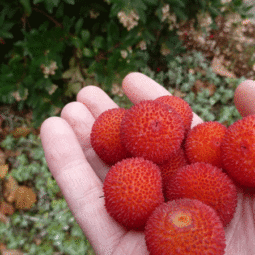One spot that still sits bare in my garden is on the north side of our house, which is in mostly full shade. I focus largely on edibles and it can be slim pickings finding a shade-loving fruiting plant. Enter this great problem solver: Evergreen huckleberry.
Evergreen huckleberry, botanically known as Vaccinium ovatum, is an evergreen shrub native here in Western Oregon. It is actually native all the way from British Columbia down to the California coasts. The shrub can grow anywhere from 3′-15′ wide and 3′-5′ wide, although most nurseries estimate it will grow to about 8′ in the shade.
It prefers shade, but does well in partial shade too. I have seen people plant it in full sun and it stays quite small and seems to struggle. If you live on the coast, it can do well in the sun because coastal air and soil stays quite moist and cool.
(Photo courtesy of One Green World)
In Spring, the plant will produce delicate little pink-white flowers that will turn into black huckleberries in September. The twigs have a red-tinge to them, contrasting with the dark green leaves. It does well in moist, well-drained and acidic soil.
There you have it – an evergreen, structural shrub that loves shade, produces both flowers and berries, and cane do well in acidic soil. Problem spot solved!







 This cluster was about the siz
This cluster was about the siz




 I start with a
I start with a

